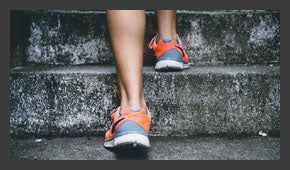You've heard of it. You know you're not supposed to walk around in bare feet in the gym locker room because you can catch it. But what is it? Athlete's foot, known medically as tinea pedis, is a common skin infection of the feet caused by fungus. There are a few different types of fungi that cause this condition including species of Trichophyton, Epidermophyton, and Microsporum. The fungus takes easily to human skin and is highly contagious once it is acquired. It is most commonly found in damp socks, shoes and thrives in warm, humid conditions that allow it to grow, like swimming pool areas, locker rooms, wrestling mats, etc. It is estimated that one in five people will get Athlete's Foot and it is more common in men than women.
A common misconception about Athlete's foot is that it's always itchy. This is a false assumption. If you notice redness, dry patches and scaling skin on your feet, have it checked out, it could be Athlete's Foot. Although it is treatable, it can be one of the most frustrating things to happen to your feet. It's not easy to get rid of and can keep coming back. You changed your socks and tried to keep your feet dry but alas, the fungus keeps finding your feet. The good news is Athlete's foot can and will go away with simple treatment and prevention.
Many people will try home remedies to treat Athlete's Foot, like Listerine or even urinating in the shower. These do not work. It is possible that Athlete's Foot will resolve on it's own with washing your feet daily, wearing dry socks and breathable shoes, however this is very unlikely. Most cases need to be treated with a topical anti-fungal medication in combination with wearing dry, clean socks breathable shoes and washing feet daily. In severe cases and recurrences, an oral anti-fungal medication can be prescribed. While being treated for Athlete's Foot, toenails should also be clipped short and kept clean. Nails can house and spread the infection. Recurrence of athlete's foot can be prevented with the use of anti-fungal powder on the feet and in shoes.
Everyone is susceptible to Athlete's foot. If not treated correctly, the fungus can easily spread to the hands, nails and groin area. (This same fungus is also associated with causing ringworm and jock itch!) It is important to avoid touching the affected area with anything used on other parts of the body, or with any part of the body itself. With proper treatment and prevention, the time it takes to get rid of the fungus will shorten and your feet will be back to normal relatively quickly. Contact your podiatrist if you believe you may have Athlete's foot because no one likes the fungus among us! See, we told you this could change your life.
Written by
Dr. Jeffrey S. Hurless
DPM, FACFAS Board Certified Foot & Ankle Surgeon/Podiatrist
Medical Director, HealthyFeetStore.com
 |
 |
